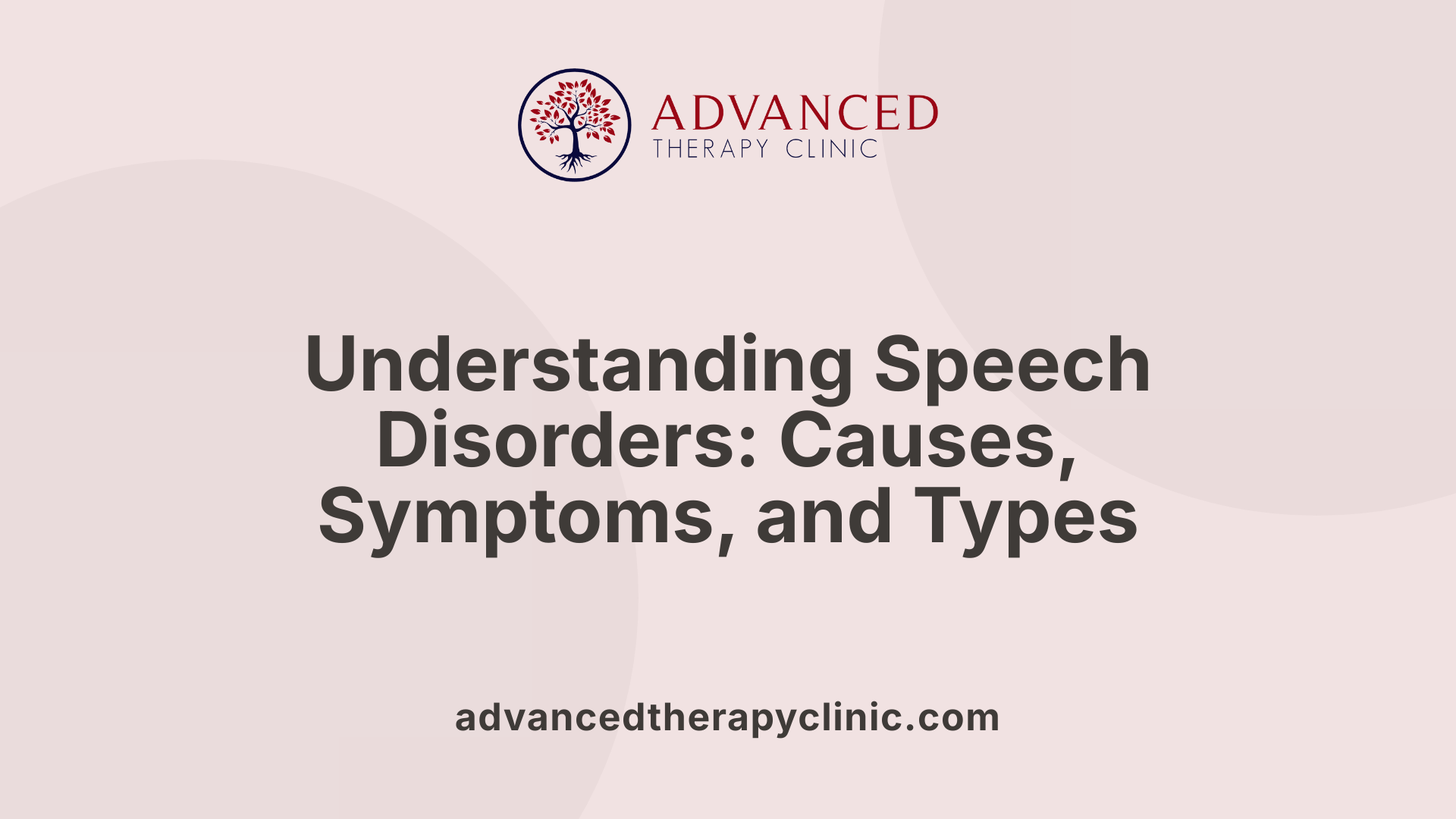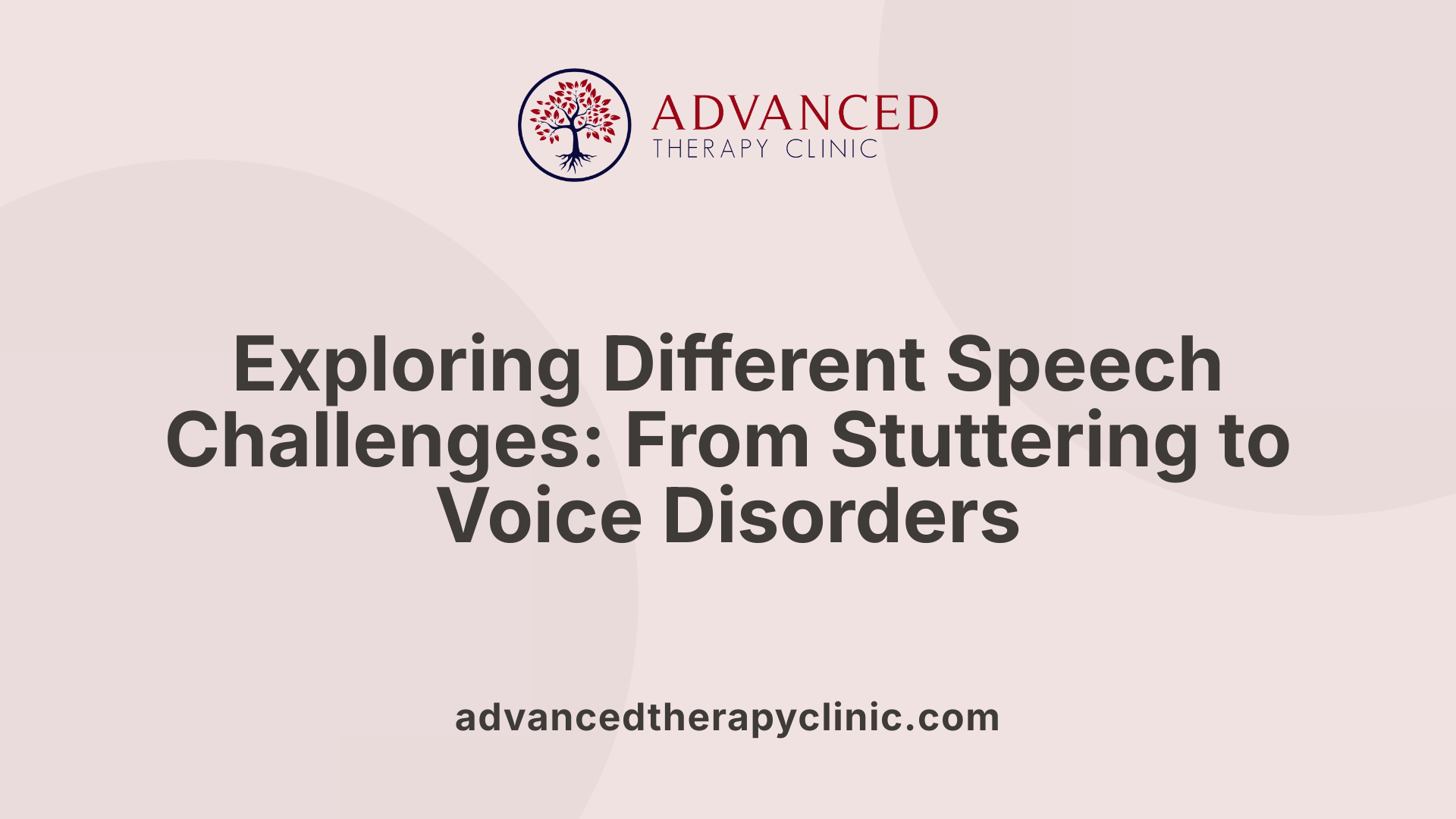Speech Disorder


An In-Depth Exploration of Communication Challenges
Speech disorders are a diverse group of conditions that impede effective communication. Affecting both children and adults, these disorders can impact social interactions, learning, and emotional well-being. Recognizing their signs, understanding their causes, and exploring treatment options are vital steps toward improving quality of life for individuals affected.
What is a Speech Disorder?

What is a speech disorder?
A speech disorder is a condition that impairs a person's ability to produce normal speech sounds necessary for effective communication. These disorders can result from physiological issues such as damage to the muscles, nerves, or vocal structures, or from neurological and developmental factors.
Common types include stuttering, apraxia, and dysarthria. Stuttering is characterized by involuntary disruptions like repetitions, prolongations, and blocks, which can cause frustration and social challenges. Apraxia involves difficulty planning and coordinating the muscle movements needed for speech, leading to distorted or inconsistent speech patterns. Dysarthria results from weakened muscles due to brain injury or neurological conditions, causing slurred or slow speech.
How do speech and language disorders differ?
While speech disorders focus on the production of sounds and voice quality, language disorders involve difficulty understanding or using words and sentences effectively. For example, a child might have trouble pronouncing words (speech disorder) or struggle to find the right words to express thoughts (language disorder). Both issues can co-occur but require different assessment and treatment approaches.
What causes speech impairments?
The causes of speech disorders are diverse. They include physiological factors like nerve or muscle damage, structural abnormalities such as a cleft palate, and neurological issues such as brain injuries, stroke, or neurodegenerative diseases like Parkinson’s or Alzheimer’s. Developmental conditions like autism spectrum disorder and Down syndrome also often include speech impairments. Hearing loss is another significant contributor since it limits the ability to perceive sounds accurately, hindering speech development.
How do speech disorders impact communication?
Speech impairments can significantly affect an individual’s ability to express themselves and understand others. This can lead to social isolation, anxiety, and lowered confidence, particularly in children who are still developing social skills and academic competence. Left untreated, these difficulties may cause long-term challenges in education, employment, and personal relationships. Early diagnosis and intervention through speech therapy are crucial to improve communication abilities and support emotional well-being.
Common Types of Speech Disorders

What are common types of speech disorders?
Speech disorders encompass a range of conditions that affect how individuals produce or organize speech sounds, voice, and fluency, creating barriers to effective communication.
One of the most frequently recognized speech issues is fluency disorders such as stuttering and cluttering. Stuttering is characterized by involuntary repetitions, prolongations, and hesitations in speech, which can vary based on stress or emotional state. It may also involve physical signs like face tension or rapid blinking. Cluttering, on the other hand, results in rapid, jumbled speech that can be difficult to understand, though it typically does not affect comprehension.
Speech sound disorders are another major category, involving difficulty with articulating sounds correctly. This includes apraxia of speech, a motor planning disorder where the brain struggles to coordinate the muscle movements required for speech, leading to distorted or inconsistent speech. Articulation disorders involve errors in producing specific sounds, like substituting 'coo' for 'school,' impacting clarity.
Voice disorders are related to problems with vocal cord function, which can cause hoarseness, pitch changes, or vocal fatigue. These issues often stem from misuse, overuse, or medical conditions such as vocal nodules or laryngitis.
Resonance disorders affect the quality of voice due to abnormal airflow through the nose or mouth. Hyponasality (a 'stuffy' sound) occurs when nasal sounds are insufficient, while hypernasality results from excessive nasal resonance, common in conditions like cleft palate.
In addition to these, developmental and acquired disorders can also significantly impair speech. For instance, Childhood Apraxia of Speech (CAS) is a developmental condition where the brain has trouble planning speech movements, leading to inconsistent errors and difficulty speaking clearly. Dysarthria, caused by neurological damage, results in weak or slow speech muscles, causing slurred or mumbled speech.
Overall, these various speech challenges are diagnosed and managed by speech-language pathologists who tailor treatment to each individual's specific needs. Recognizing these different types of disorders helps in early intervention and effective therapy, improving communication and quality of life for affected individuals.
| Disorder Type | Description | Typical Symptoms | Common Causes |
|---|---|---|---|
| Fluency Disorders | Affect speech flow, causing repetitions, blocks, or prolongations | Stuttering, cluttering | Neurophysiological factors, developmental issues |
| Speech Sound Disorders | Difficulty with sound production and articulation | Substitutions, omissions, distortions | Structural abnormalities, neurological damage |
| Voice Disorders | Issues with pitch, loudness, or voice quality | Hoarseness, vocal fatigue | Misuse, nodules, infections |
| Resonance Disorders | Abnormal nasal airflow affecting voice | Hyponasality, hypernasality | Cleft palate, neurological impairment |
| Developmental & Acquired Disorders | Various origins affecting speech development or muscle control | Inconsistent errors, slow speech | Brain injury, genetic factors, neurodevelopmental conditions |
Understanding and addressing these types significantly enhance communication capabilities and overall well-being.
Recognizing Symptoms and Causes

What are the symptoms and signs of speech disorders?
Speech disorders present through a variety of symptoms that can affect both children and adults. Common signs include involuntary repetitions, prolongations, or blocks of sounds or words, which are typical in fluency disorders like stuttering. Individuals might also find it difficult to pronounce words clearly, resulting in speech that is hard to understand.
Voice alterations are also prevalent, such as hoarseness, a raspy tone, or breathy sounds, indicating possible voice or vocal cord issues. Speech may appear slowed, hurried, or hesitant, reflecting underlying difficulties in speech coordination or fluency.
Additional indicators involve substituting, omitting, or adding sounds or syllables. During speech, some may show jerky or inconsistent movements, signaling motor speech impairments like apraxia or dysarthria. Frustration or visible effort while speaking, alongside unintelligibility and limited clarity, can further suggest a speech problem.
Some individuals might rely on gestures or non-verbal cues instead of speech. Early identification through these signs is crucial, as speech-language pathologists can provide targeted treatment to improve communication skills.
What causes speech disorders?
The origins of speech disorders are diverse, often involving a combination of neurological, physical, developmental, and psychological factors. Neurological conditions such as stroke, traumatic brain injury, or degenerative diseases like Parkinson’s and multiple sclerosis can damage the brain regions responsible for motor control and speech coordination.
Physical impairments affecting the muscles or nerves involved in speech—such as muscle weakness (dysarthria), structural anomalies like cleft palate, or vocal cord nodules—can impair speech development.
Developmental delays in motor or cognitive skills play a significant role, especially in children with conditions like autism spectrum disorder, Down syndrome, or childhood apraxia of speech. Psychological factors, including trauma or anxiety, may also trigger or exacerbate speech issues, as seen in neurogenic or psychogenic stuttering.
Hearing loss significantly impacts speech development, making it harder to acquire clear articulation and fluency patterns. Brain damage from strokes or injury frequently results in aphasia or other language impairments, affecting how individuals produce and understand speech. Overall, the causes are often complex, requiring comprehensive evaluation for accurate diagnosis and effective treatment.
Assessment and Treatment Strategies
 Diagnosing speech disorders involves a thorough process primarily carried out by speech-language pathologists (SLPs). These professionals utilize a combination of clinical observation, standardized tests, and speech sample analysis to identify specific issues.
Diagnosing speech disorders involves a thorough process primarily carried out by speech-language pathologists (SLPs). These professionals utilize a combination of clinical observation, standardized tests, and speech sample analysis to identify specific issues.
Standardized tools such as the Denver articulation screening exam, the prosody-voice profile, and the Denver early language milestones scale help pinpoint where a person’s speech deviates from typical developmental patterns. During evaluation, the SLP examines the movement and coordination of the lips, tongue, jaw, and other muscles involved in speech. Medical history, family background, and hearing status are also reviewed to exclude or identify contributing factors.
In children, diagnosis often involves a multidisciplinary team that includes otolaryngologists and audiologists, especially if hearing loss or structural abnormalities are suspected. Hearing assessments are vital because hearing difficulties can significantly impact speech development.
Once a comprehensive assessment is complete, the clinician can determine the specific type of speech disorder—such as articulation, phonological, fluency, voice, or resonance issues—and tailor an intervention plan.
Treatment approaches for speech disorders are multifaceted. Speech therapy remains the cornerstone of intervention, delivered by trained SLPs through a variety of techniques. Practice sessions focus on improving speech sound production, enhancing fluency, and strengthening voice quality.
Therapists may use exercises to build muscle strength in the face and mouth, facilitate accurate sound and word production, and incorporate contrast therapy to help distinguish between correct and incorrect sounds. Contextual and naturalistic approaches, involving real-life communication situations, promote generalization of skills.
Behavioral strategies are also common, including positive reinforcement and modeling to encourage progress. For some individuals, assistive devices like speech-generating devices or communication boards supplement therapy.
In cases where speech issues stem from neurological injury or structural problems, medical interventions or surgical procedures might be required. Medications may help manage comorbid conditions like anxiety or depression that interfere with speech therapy.
Overall, early assessment and intervention are critical to optimize communication skills and reduce long-term social, academic, or psychological impacts. An interdisciplinary team often collaborates to address complex cases, ensuring a comprehensive treatment plan tailored to each person's specific needs.
Prevalence and Impact of Speech Disorders
Speech disorders are quite common across different age groups. In children, around 5% to 8-9% experience speech sound or language difficulties that may affect their learning and social interactions. Developmental issues such as stuttering are seen in about 1% of the population, typically emerging in early childhood and sometimes persisting into adulthood. In adults, speech and voice disorders—often caused by neurological injuries, diseases like Parkinson's, or medical conditions such as stroke—affect approximately 4% to 7% of the population. These conditions can impact an individual’s ability to communicate effectively, influencing daily life and career opportunities.
The effects of speech disorders extend beyond mere communication. Children with untreated speech difficulties may face academic challenges, social isolation, and low self-esteem. Similarly, adults with untreated issues can experience increased anxiety, depression, and social withdrawal. Speech impairments can hinder personal relationships and job performance, emphasizing the importance of timely diagnosis and intervention.
Early detection plays a vital role in improving outcomes. Identifying speech issues between ages 2 and 4 allows professionals to implement specialized therapy early on, helping children to develop clearer speech, better social skills, and confidence. For adults, early diagnosis helps manage underlying causes like neurological damage, potentially reversing or reducing the severity of speech difficulties. Recognizing and addressing speech disorders early helps individuals lead healthier, more connected lives, underlining the importance of awareness and prompt action for effective treatment.
Supporting Effective Communication
Understanding and addressing speech disorders is essential for fostering effective communication and enhancing individuals' social, educational, and psychological well-being. Early diagnosis, personalized treatment plans, and ongoing support from trained professionals can greatly improve outcomes. Public awareness and education also play a crucial role in reducing stigma and encouraging those affected to seek help. Recognizing that speech disorders are common and treatable encourages a supportive environment where everyone can develop their communication abilities and participate fully in society.
References
- Speech Impairment: Types, Signs & Causes - Cleveland Clinic
- Speech disorder - Wikipedia
- Speech disorders: Types, symptoms, causes, and treatment
- Speech disorders - children: MedlinePlus Medical Encyclopedia
- Speech and Language Disorders - ASHA
- Speech Impediment Guide: Definition, Causes & Resources
- Help for speech, language disorders - Mayo Clinic Health System
Recent articles

Expressive Speech Delay 2-Year-Old
Understanding and Addressing Expressive Speech Delay in Toddlers

How Speech Recognition Works
Unlocking the Power of Speech Recognition in Therapy and Healthcare

Autism and Head Size
Understanding the Complex Relationship Between Autism and Head Size

Occupational Therapy in Autism
Enhancing Independence and Quality of Life Through Occupational Therapy in Autism

Do Autistic People Understand Sarcasm?
Navigating the Nuances: Understanding Sarcasm and Social Communication in Autism

Autism Routines
Crafting Effective Daily Structures for Children with Autism

